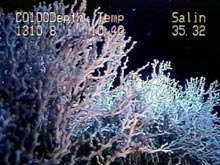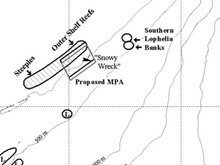
Slow-growing Lophelia coral grow sporadically along North Carolina's continental shelf. The science party will be visiting these rare habitats.
Life on the Edge
Exploring Deep Ocean Habitats
August 16 - 27, 2003
Located off the Carolinas are unique and productive deep-water habitats (100 to 1,000 m) that are largely unstudied. These areas are the transition zone between the continental shelf and the true deep sea. Two of these habitats, the outer shelf hard grounds and midslope deep coral (Lophelia) banks, were the focus of this expedition. Throughout most of the study area, these habitats are separated by no more than a few kilometers. Despite some physical similarities, however, they seem to be vastly different both in community structure and sea-life interaction. Thus, these reef habitats presented a unique opportunity to compare and contrast closely associated ecosystems.

The Northern and Southern Lophelia Banks were sampled during several recent research cruises, including this one. Click image for larger view.
During this expedition, researchers explored unknown portions of these habitats and defined their faunal composition (the numbers and types of sea life found there). They also collected data to support a proposed Marine Protected Area on the outer continental shelf. Samples were taken throughout the entire water column, using a variety of techniques, to identify the full spectrum of sea life and the associated hydrography (water conditions) in each study area. By collecting data from benthic (bottom) habitats to surface waters, researchers hoped to gain a better understanding of the mechanisms that control and differentiate community structures throughout the water column along the gradient of the continental shelf and continental slope.
Background information for this exploration can be found on the left side of the page. Daily updates and logs that summarize expedition activities are posted below and to the right.
Updates & Logs
Click images or links below for detailed mission logs.
 Aug 27 The sea, like the night sky, is full of wonderful stars. We call them echinoderms.
Aug 27 The sea, like the night sky, is full of wonderful stars. We call them echinoderms. Aug 26 What happens to the scientific collections after the cruise? Read about how the end of the mission is just the beginning.
Aug 26 What happens to the scientific collections after the cruise? Read about how the end of the mission is just the beginning. Aug 25 Learn about Flyingfishes in the waters off North Carolina, and the challenges faced in collecting them.
Aug 25 Learn about Flyingfishes in the waters off North Carolina, and the challenges faced in collecting them. Aug 24 The team collects data from benthic habitats to surface waters in the unique outer shelf and slope “reef” habitats.
Aug 24 The team collects data from benthic habitats to surface waters in the unique outer shelf and slope “reef” habitats. Aug 23 An educator descends to a depth of 1400 feet.
Aug 23 An educator descends to a depth of 1400 feet. Aug 22 Due to unpredictable weather and shooting conditions, filming on board presents a unique set of challenges.
Aug 22 Due to unpredictable weather and shooting conditions, filming on board presents a unique set of challenges. Aug 21 What’s for Dinner? Collecting data for a glimpse at the community structure of habitats off the coast of North Carolina.
Aug 21 What’s for Dinner? Collecting data for a glimpse at the community structure of habitats off the coast of North Carolina.  Aug 20 Read about the long anticipated Media Day on the Seward Johnson.
Aug 20 Read about the long anticipated Media Day on the Seward Johnson. Aug 19 Exploring the outer continental shelf: Invertebrate Fauna on the Outer Shelf and Lophelia Banks.
Aug 19 Exploring the outer continental shelf: Invertebrate Fauna on the Outer Shelf and Lophelia Banks. Aug 18 It is not well known except by a few fishermen; and it has never been confirmed as a ship wreck…until now.
Aug 18 It is not well known except by a few fishermen; and it has never been confirmed as a ship wreck…until now. Aug 17 The first full day at sea. Explicit data collection to identify Lophelia coral locations.
Aug 17 The first full day at sea. Explicit data collection to identify Lophelia coral locations. Aug 16 The team prepares for the journey. Read about the mobilization efforts.
Aug 16 The team prepares for the journey. Read about the mobilization efforts.




















